SS France Archival Collection
Content Links
- France (1867) National Line (British) Ship's History (Brief)
- France (1912) French Line Ship's History (Brief)
- France (1961) French line Ship's History (Brief)
- Passenger Lists
- Brochures
- Programs
- Sailing Schedules
- Title Pages
- Senior Officers and Staff
- Route Maps, Track Charts, Abstract of Logs
- Back Cover Images
- Fleet List
- Illustrations and Paintings
- Photographs
- Excerpts from Information for Passengers
- Postcards
- Advertisements
- The Steamship "France" of the French Line - 1912
- Books Referencing the SS France
France (1867) National Line (British)
Built by T. Royden & Sons, Liverpool, England. Tonnage: 3,572. Dimensions: 385' x 42'. Single-screw, 12 knots. Inverted engines. Three masts and one funnel. Clipper bow. Iron hull. Launched: 4 July 1867. Maiden voyage: Liverpool-New York, 13 October 1867. Modifications: Vessel enlarged to 4,281 tons in 1875. Compound engines in 1880. Final Voyage: To New York in 1893. Sister ships: England and Denmark.
France (1912) French Line
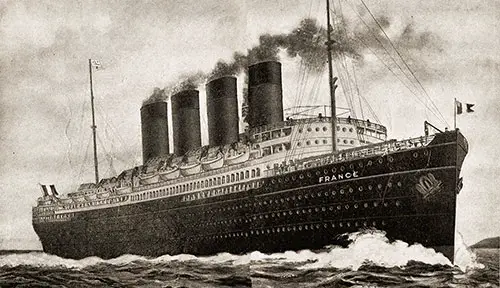
Illustration of the SS France of the CGT French Line. SS Chicago Passenger List, 15 April 1919. GGA Image ID # 157b499d79
Built by Chantiers & Ateliers (Penhoet), St. Nazaire, France. Tonnage: 23,769. Dimensions: 690' x 75' (720' o.l.). Propulsion: Quadruple-screw, 24 knots. Four steam turbines. Masts and Funnels: Two masts and four funnels. Keel laid in February 1909. Launched: 20 September 1910. Passengers: 535 first, 440 second, 950 third. Maiden voyage: Havre-New York, 20 April 1912. Speed: During her speed trials made 25.9 knots. Noted as a very fast liner, and the nearest in speed to the Lusitania and Mauretania of that era. Made the run between Havre and New York in 5 days, 17 hours. World War I Service: Renamed France IV for the French Navy. Used as troopship, and also in role of hospital ship. Post War Service: Returned to passenger service in August 1919. Modifications: Converted from coal to oil fuel in 1923. Fate: Laid up at Le Havre in September 1932. Broken up by Dunkirk shipbreakers in 1936.
France (1961) French line
Built by Chantiers de F Atlantique, St. Nazaire, France. Tonnage: 66,000. Dimensions: 1,035' (o.l.) x 110'. Propulsion: Quadruple-screw, 31 knots. Steam turbines. Masts and Funnels: Single-mast and two funnels. Keel laid 7 October 1957. Launched: 11 May 1960. Unique Characteristics: The 8 boilers installed will develop a total of 160,000 H.P. Equipped with stabilizers, which should cut roll to less than two degrees. Speed: Attained a speed of 34.13 knots during her trials in November 1961. There are 11 decks. Capacity: Accommodation for 500 first and 1,500 tourist. Maiden voyage: Havre- New York, 3 February 1962. Service: Southampton-Le Havre-New York and Winter Cruises. Sale: Purchased by Norwegian Cruise Line (NCL) in 1979, renamed SS Norway (1980–2006) and SS Blue Lady (2006–2008). Modifications: Underwent significant modifications in 1979 to refit her for cruising duties. Fate: Out of Service in May 2003 and Scrapped in 2006.
Return to Content Links
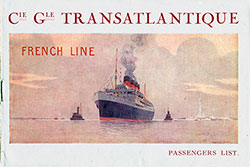
1921-10-03 SS France Passenger List
Steamship Line: Compagnie Générale Transatlantique CGT - French Line
Class of Passengers: First and Second Class
Date of Departure: 3 October 1921
Route: Le Havre to New York
Commander: Captain Louis Roch

1922-10-05 SS France Passenger List
Steamship Line: Compagnie Générale Transatlantique CGT - French Line
Class of Passengers: First and Second Class
Date of Departure: 5 October 1922
Route: Le Havre to New York via Plymouth
Commander: Captain Louis Roch
Récapitulation: 298 First Class, 419 Second Class, 306 Third Class, 1,023 Total Passengers

1924-09-27 SS France Passenger List
Steamship Line: Compagnie Générale Transatlantique CGT - French Line
Class of Passengers: First and Second Class
Date of Departure: 27 September 1924
Route: Le Havre to New York via Plymouth
Commander: Captain Louis Roch
Récapitulation: 423 First Class, 242 Second Class, 73 Third Class, 738 Total Passengers.

1931-01-10 SS France Passenger List
Steamship Line: Compagnie Générale Transatlantique / French Line (CGT)
Class of Passengers: First and Tourist
Date of Departure: 10 January 1931
Route: New York to Marseilles via Vigo, Casablanca, Rabat, Gibraltar, Naples, Capri, Monaco, and return via Le Havre or directly to New York
Commander: Captain G. Burosse

1931-05-29 SS France Passenger List
Steamship Line: Compagnie Générale Transatlantique CGT - French Line
Class of Passengers: First and Second Class
Date of Departure: 29 May 1931
Route: New York to Le Havre via Plymouth
Commander: Captain G. Burgosse
Récapitulation: 198 First Class, 91 Second Class, 197 Third Class, 486 Total Passengers.
Return to Content Links
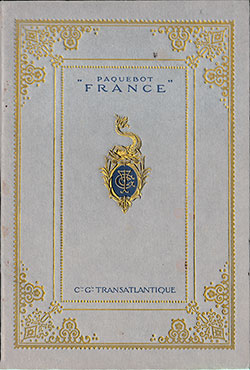
Le Nouveau Paquebot SS France 1912
Il s'agit d'une brochure pour le lancement Steamship SS France de la CGT-French Line produite en 1912 qui offre une excellente critique du livre de l'hébergement de première classe, des services, des détails de la salle des machines et des chaudières, des dispositions et beaucoup plus.

The New SS France Liner - 1912
This is a brochure for the Steamship SS France launch of the CGT-French Line produced in 1912 which offers an excellent review of the book of first class accommodation, services, details of the engine room and boilers, provisions and much more. Translated from the French.
The Compagnie Générale Transatlantique issued this beautiful brochure to present its luxurious new ocean liner, the FRANCE.
This rare original brochure dates from 1912 and features a gold embossed cover with an early "CGT" (French Line) monogram in a blue medallion surrounded by a gold embossed dolphin and rinceaux cartouche (cartridge scrolls) in the style of the 18th-century decor used in the ship. The cover borders, inside flaps, and the borders and illustrations used in the page layout are a more modern Art Nouveau style.
The interior of the brochure is comprised of 16 pages of text in French by A. Pawlowski, illustrations, and photographs presenting the ship, including rare images of the legendary "Appartement de grand luxe" with its giltwood paneling copied faithfully from the private royal apartments at Versailles, the magnificent "Grand Hall" (the paneling of which is now displayed at the French Line museum in Le Havre) and the sumptuous "Grand Salon" with its copy of the Rigaud portrait of Louis XIV.
The center of the brochure holds a handsome two-page color artist's impression of the FRANCE in New York harbor.
The last two pages are dedicated to the "Ventre du Monstre," the "Monster's Stomach," and extolling the many virtues of Compagnie Générale Transatlantiques cuisine, listing the incredible quantities of beef, fish, wine, etc., brought on board for every voyage.
This first brochure emphasizes style and cuisine over safety. However, a section on the ship's engine room mentions the watertight door and compartment system. It is interesting to note that the FRANCE's maiden voyage took place on April 20th, 1912, just five days after the sinking of the TITANIC. The French vessel had sufficient lifeboats for the 2,558 souls on board right from the start and did not have to be altered due to the TITANIC disaster.
Return to Content Links
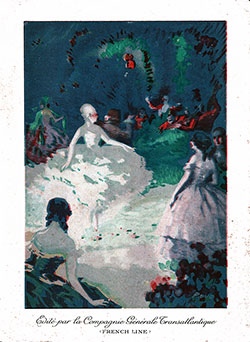
1931-01-22 Piano Recital by Jacqueline NOURRIT -- SS France
Beautiful, elegant cover for a piano recital by Jacqueline NOURRIT on board the SS France of the Compagnie Générale Transatlantique French Line on 22 January 1931. Featured compositions from Schubert, Chopin, Schumann, Liszt, Ravel, Debussy, and others.
Return to Content Links
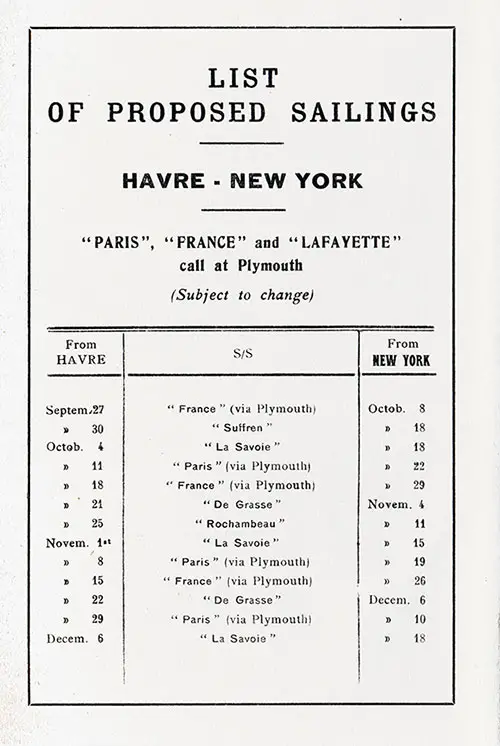
Sailing Schedule (Part 1 of 2), Le Havre-New York via Plymouth, from 27 September 1924 to 18 December 1924. Ships Included the De Grasse, France, La Savoie, Paris, Rochambeau, and Suffren. SS France Passenger List, 27 September 1924. GGA Image ID # 1e5c9e2ea0
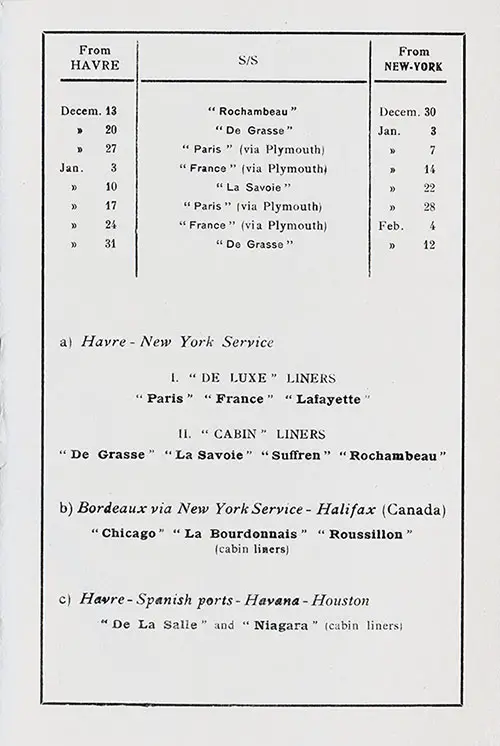
Sailing Schedule (Part 2 of 2), Le Havre-New York via Plymouth, from 13 December 1924 to 12 February 1925. Ships Included the De Grasse, France, La Savoie, Paris, and Rochambeau, and Suffren. SS France Passenger List, 27 September 1924. GGA Image ID # 1e5cd0016f
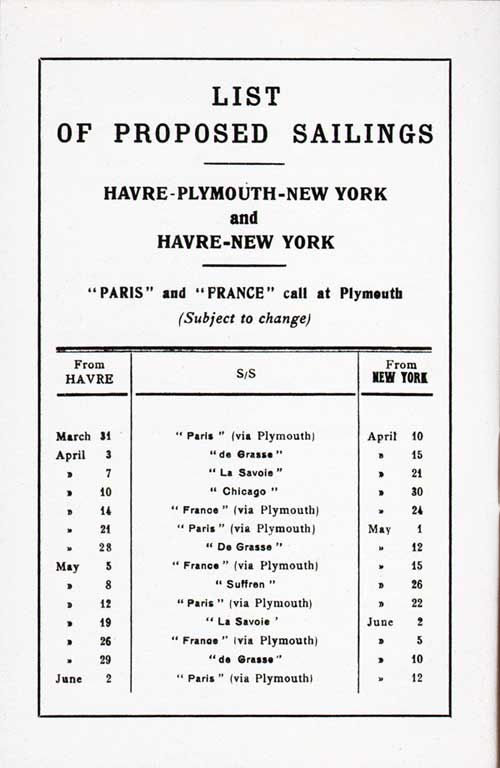
Sailing Schedule (Part 1 of 2), Le Havre-Plymouth-New York and Le Havre-New York, from 31 March 1926 to 12 June 1926. Ships Included the Chicago, France, de Grasse, La Savoie, Paris, and Suffren. SS Paris Passenger List, 31 March 1926. GGA Image ID # 1e46416fba
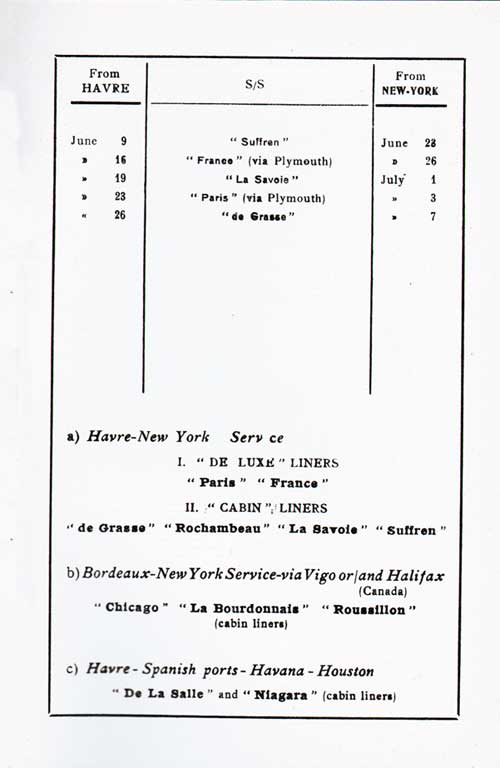
Sailing Schedule (Part 2 of 2), Le Havre-Plymouth-New York and Le Havre-New York, from 9 June 1926 to 7 July 1926. Ships Included the France, de Grasse, La Savoie, Paris, and Suffren. SS Paris Passenger List, 31 March 1926. GGA Image ID # 1e46835bb1
Return to Content Links
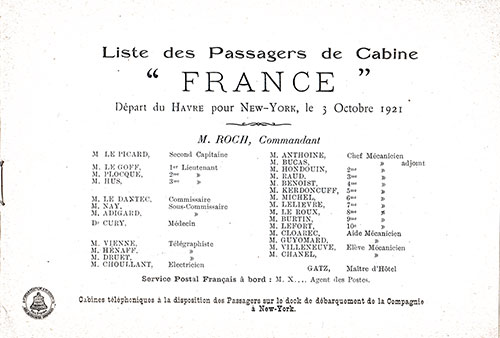
Title Page Including List of Senior Officers and Staff, SS France Cabin Passenger List, 3 October 1921. GGA Image ID # 20f48cf9c0

Title Page, SS France Cabin Passenger List, 5 October 1922. GGA Image ID # 20f55d854f

Title Page, SS France Cabin Passenger List, 27 September 1924. GGA Image ID # 20f575470b
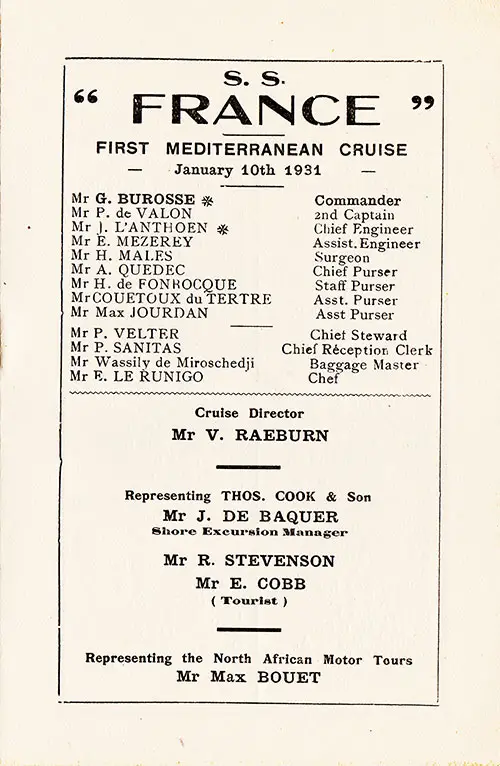
Title Page with Senior Officers and Staff Listed, SS France First Mediterranean Cruise Passenger List, 10 January 1931. GGA Image ID # 20f43a5e6d

Title Page with Listing of Senior Officers and Staff, SS France Cabin Passenger List, 29 May 1931. GGA Image ID # 20f593c9ab
Return to Content Links
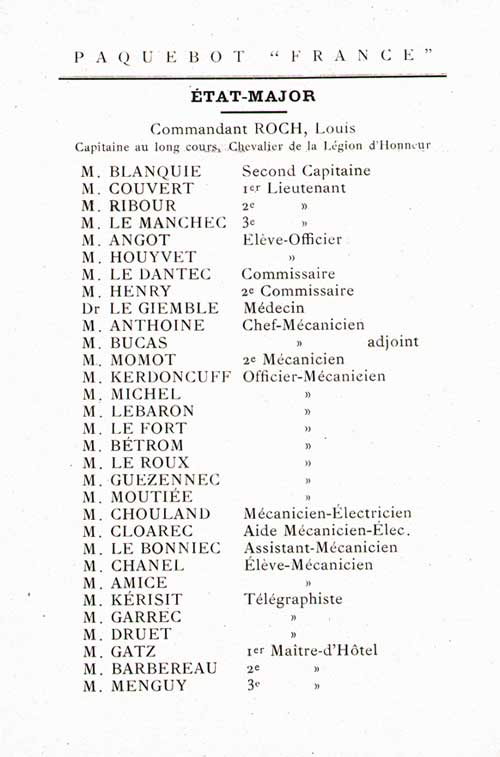
Senior Officers and Staff, SS France Cabin Passenger List, 5 October 1922. GGA Image ID # 20f56995d7
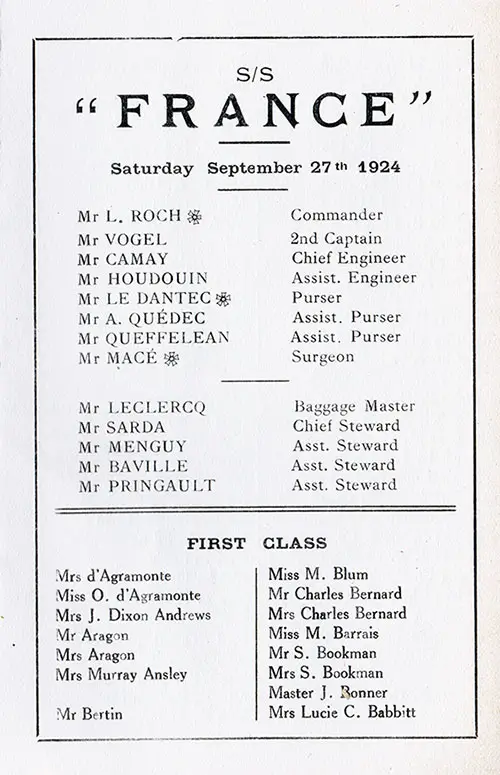
Senior Officers and Staff (With a few of the Passenger's Names), SS France First and Second Cabin Passenger List, 27 September 1924. GGA Image ID # 20f58f0fef
Return to Content Links
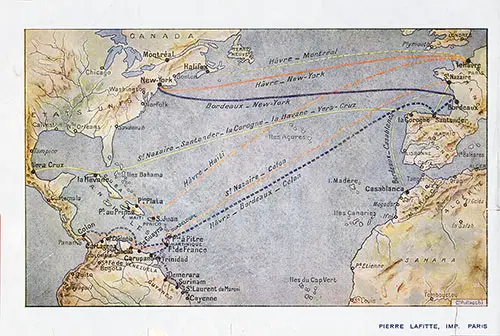
CGT French Line Route Map by Pierre Lafitte, Paris, Showing the Transatlantic Routes Used by Steamships in 1921. From the Back Cover of the SS France Passenger List for 3 October 1921. GGA Image ID # 157af09769
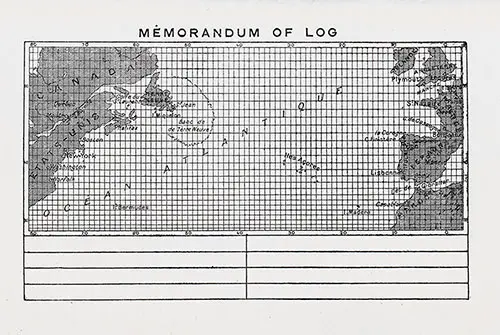
Track Chart and Memorandum of Log (Unused), SS France Passenger List, 27 September 1924. GGA Image ID # 1e5c736b08
Return to Content Links
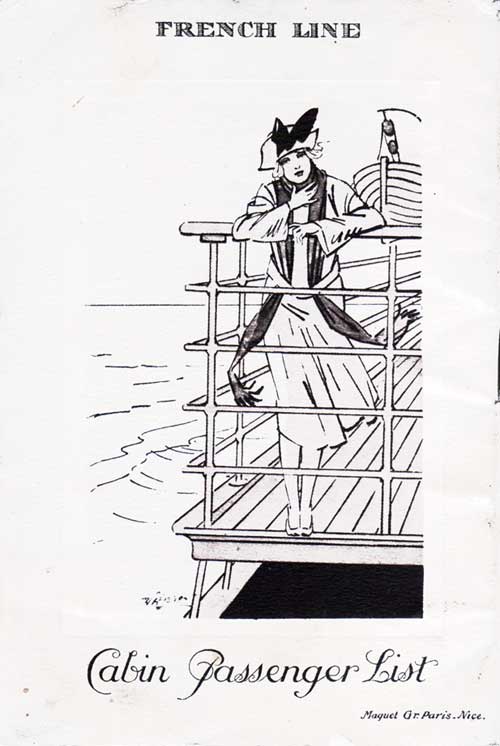
Back Cover, SS France Passenger List, 5 October 1922. Illustration by Maquet Gr. Paris-Nice. GGA Image ID # 1da8f69a7c
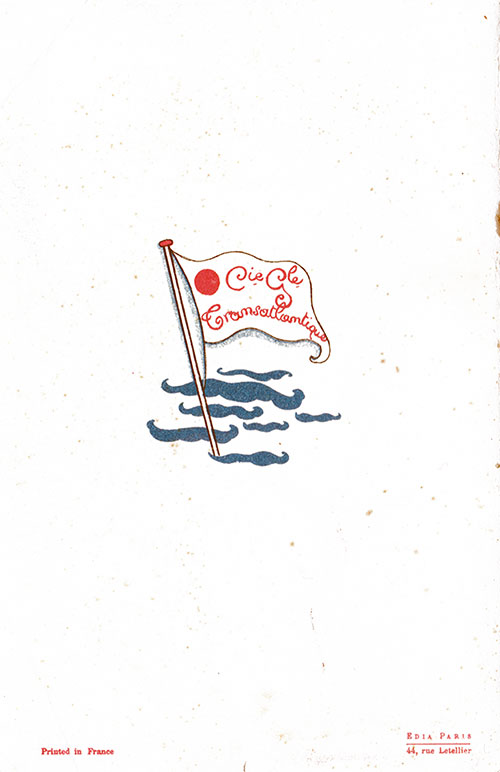
Back Cover, SS France Passenger List, 27 September 1924. GGA Image ID # 1581a576e9
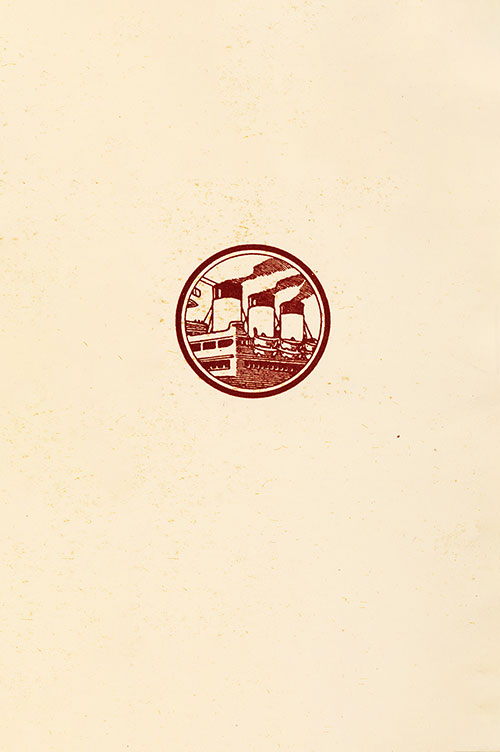
Back Cover, SS France First Mediterranean Cruise Passenger List, 10 January 1931. GGA Image ID # 20f454cce3
Return to Content Links
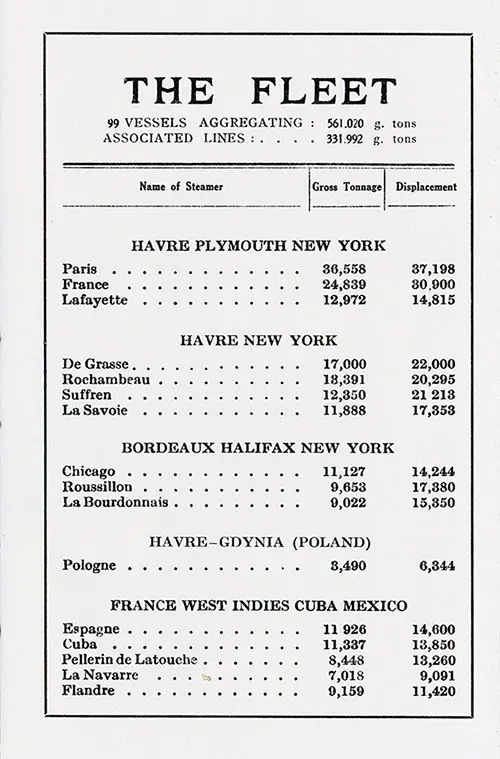
Compagnie Générale Transatlantique (CGT) French Line Fleet List, 1924, Part 1 of 4. SS France Passenger List, 27 September 1924. GGA Image ID # 1e5b0eae9d
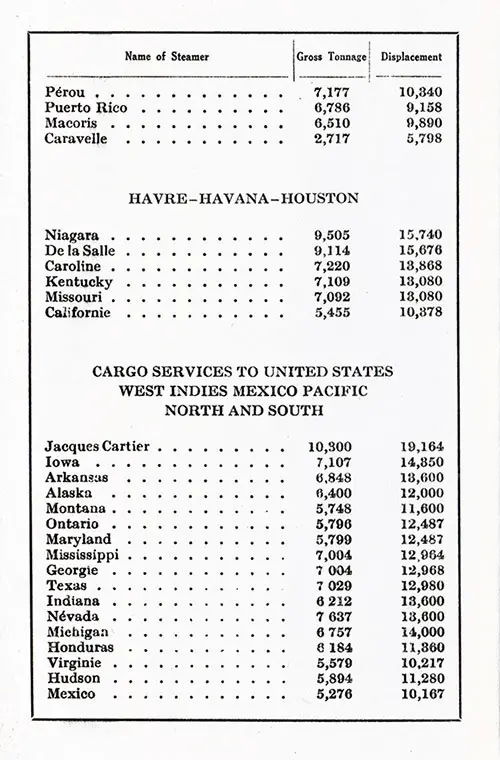
Compagnie Générale Transatlantique (CGT) French Line Fleet List, 1924, Part 2 of 4. SS France Passenger List, 27 September 1924. GGA Image ID # 1e5bc938f0
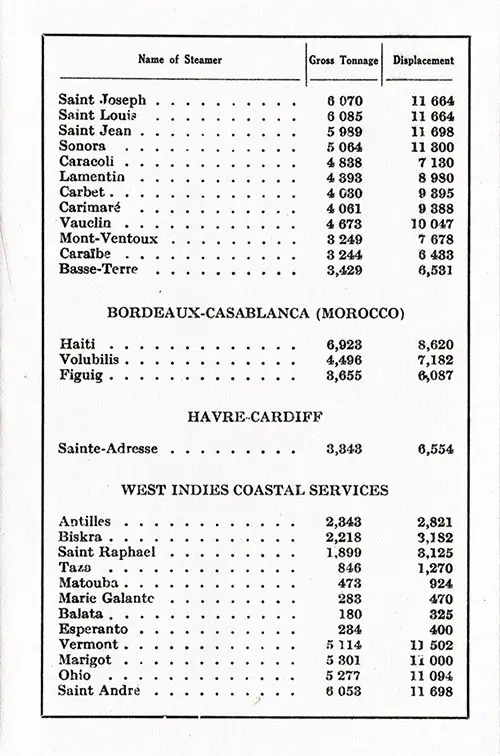
Compagnie Générale Transatlantique (CGT) French Line Fleet List, 1924, Part 3 of 4. SS France Passenger List, 27 September 1924. GGA Image ID # 1e5be287ca
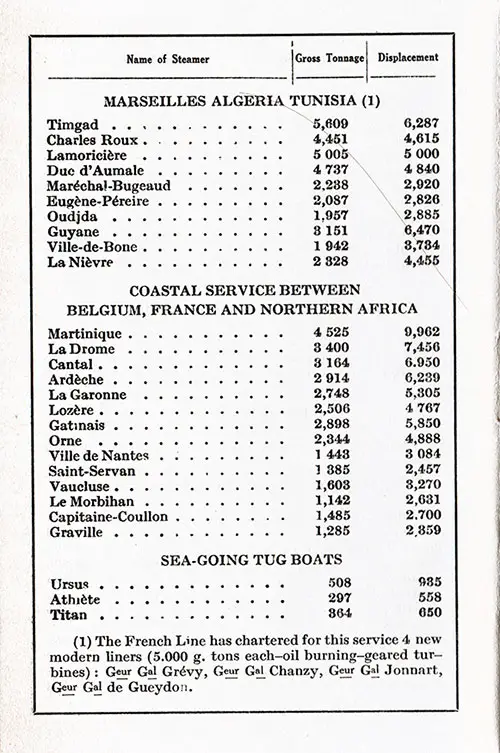
Compagnie Générale Transatlantique (CGT) French Line Fleet List, 1924, Part 4 of 4. SS France Passenger List, 27 September 1924. GGA Image ID # 1e5bf32772
Return to Content Links
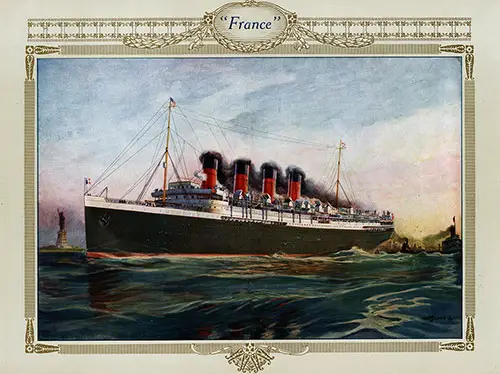
Color Painting of the SS France (1912). The New SS France Liner, 1912. GGA Image ID # 1e5de6c297
Return to Content Links
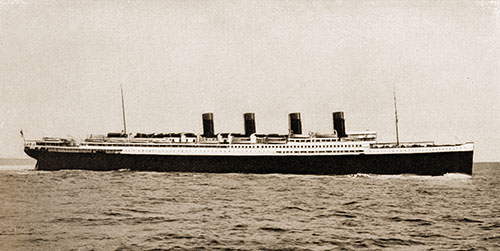
The SS "France" Ocean Liner of Compagnie Générale Transatlantique - French Line (1912). The New SS France Liner, 1912. GGA Image ID # 119c4de068
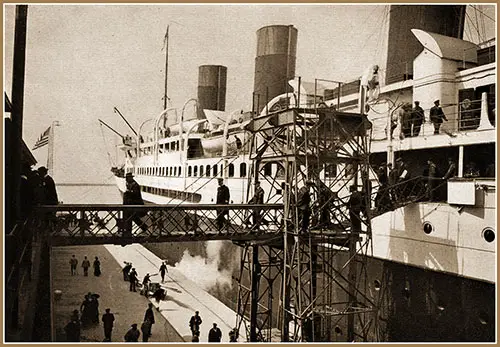
The Steamship "France" of the Compagnie Generale Transatlantique has its first departure for New York (20 April 1912). The New SS France Liner, 1912. GGA Image ID # 119c775091
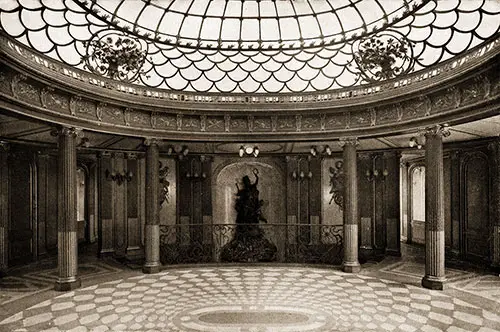
First Class Grand Hall. The New SS France Liner, 1912. GGA Image ID # 119e28f802
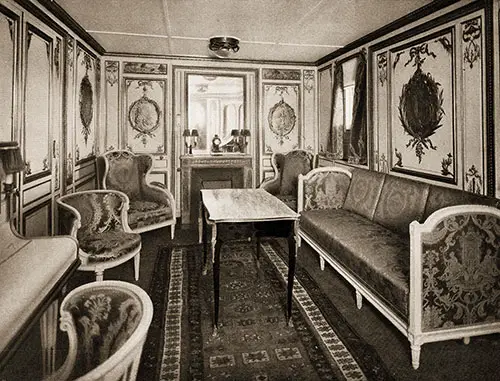
Living Room of the Luxury Suite. The New SS France Liner, 1912. GGA Image ID # 119c792ea9
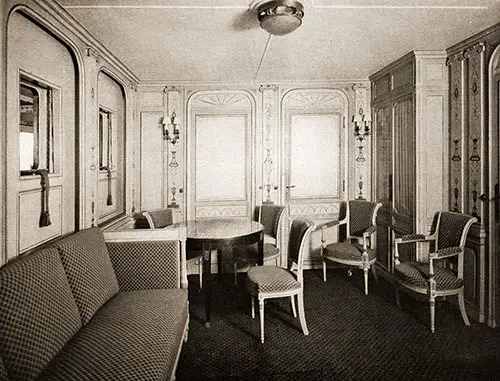
Private living room of a Luxury Suite. The New SS France Liner, 1912. GGA Image ID # 119cb54ee5
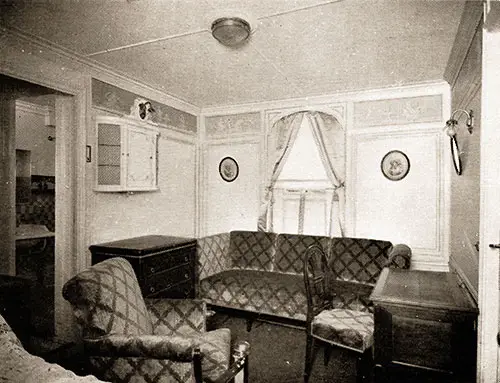
Luxury Cabin. The New SS France Liner, 1912. GGA Image ID # 119cd5ef5c
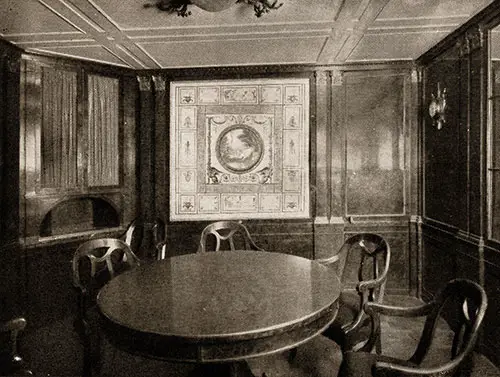
Dining Room of the Luxury Suite. The New SS France Liner, 1912. GGA Image ID # 119ca47bb9
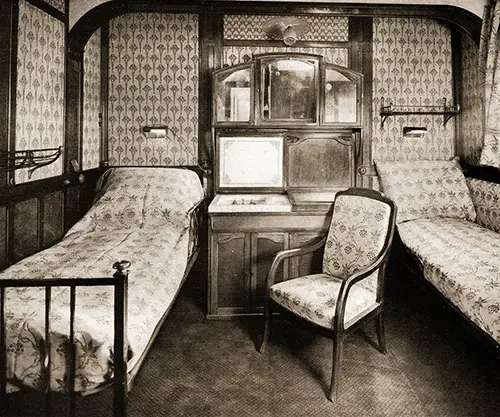
First Class Cabin. The New SS France Liner, 1912. GGA Image ID # 119ce48276
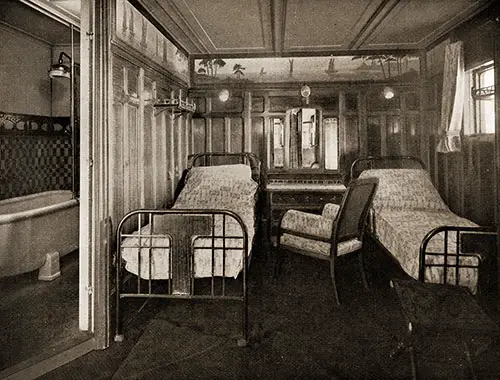
First Class Cabin with Baths. The New SS France Liner, 1912. GGA Image ID # 119cd77d20
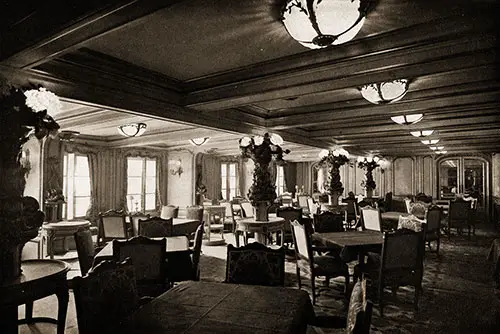
Corner of the First Class Dining Room. The New SS France Liner, 1912. GGA Image ID # 11a1c9072e
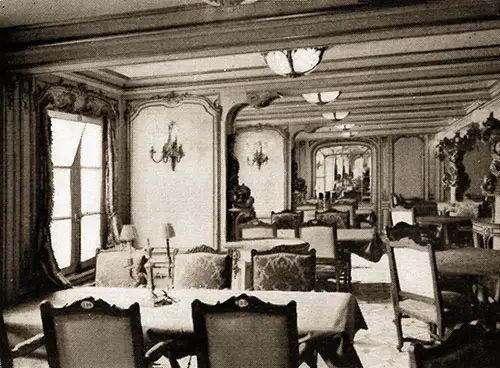
A Corner of the First Class Dining Room. The New SS France Liner, 1912. GGA Image ID # 119f859484
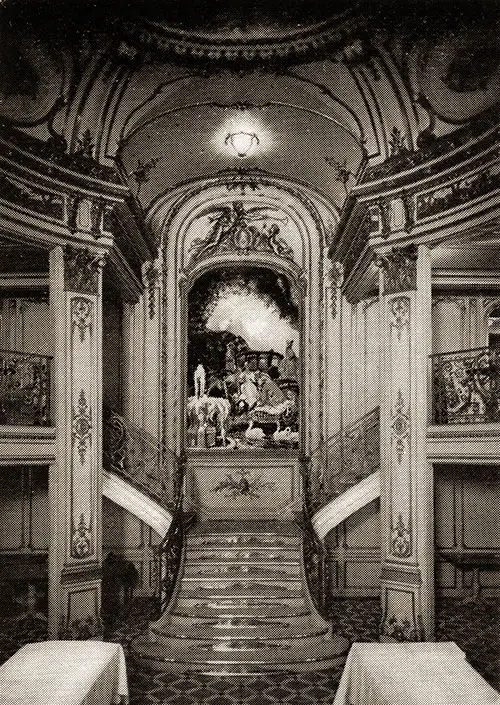
Grand Staircase of the First Class Dining Room. The New SS France Liner, 1912. GGA Image ID # 119dadec5a
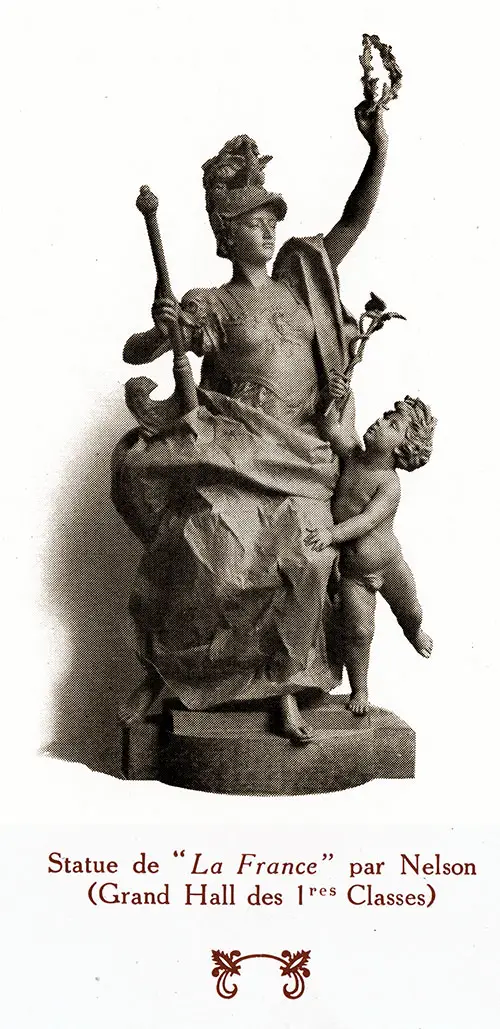
Statue of "France" by Nelson - First Class Great Hall. The New SS France Liner, 1912. GGA Image ID # 11a22ddb37
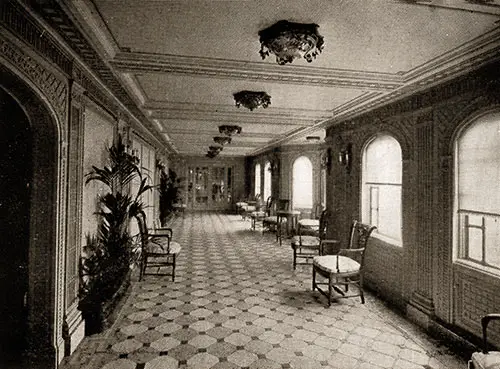
A First Class Gallery. The New SS France Liner, 1912. GGA Image ID # 11a09a9876
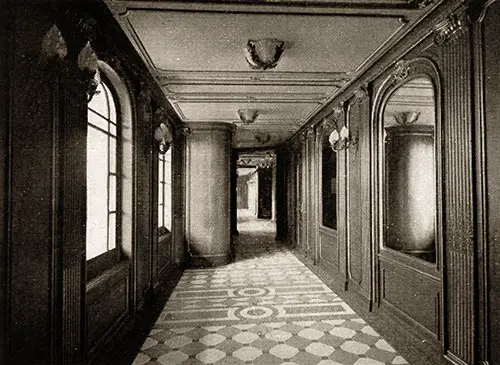
First Class Gallery. The New SS France Liner, 1912. GGA Image ID # 119edbc519
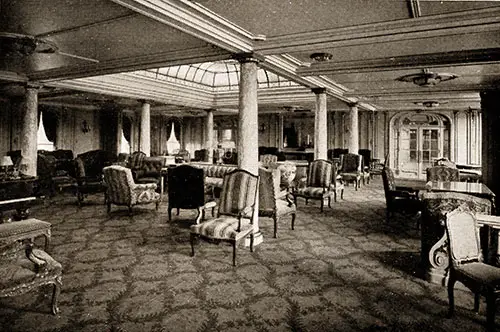
First Class Mixed Use Lounge. The New SS France Liner, 1912. GGA Image ID # 119d6db5f2
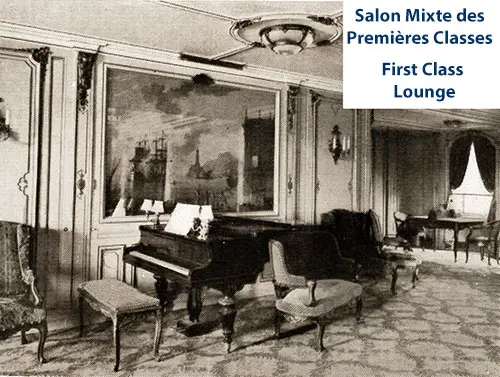
First Class Mixed Use Lounge. The New SS France Liner, 1912. GGA Image ID # 119fd69a80
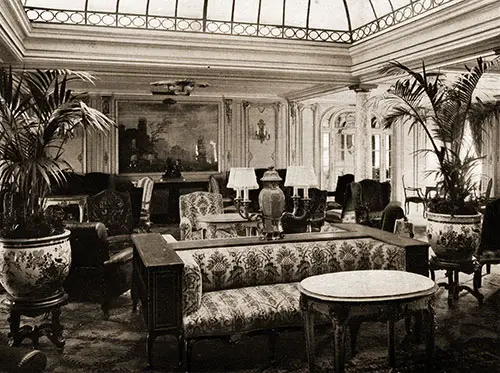
Mixed Use Lounge of the First Class. The New SS France Liner, 1912. GGA Image ID # 11a07d1293
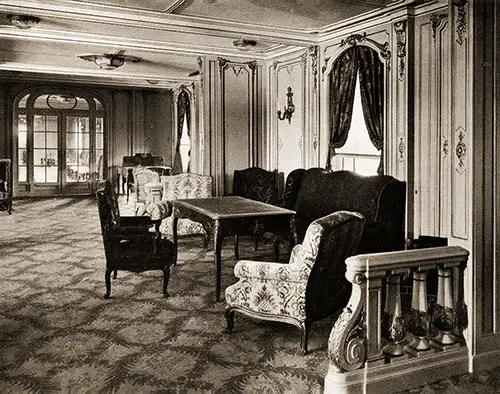
A Corner of the First Class Mixed Use Lounge. The New SS France Liner, 1912. GGA Image ID # 11a0833d61
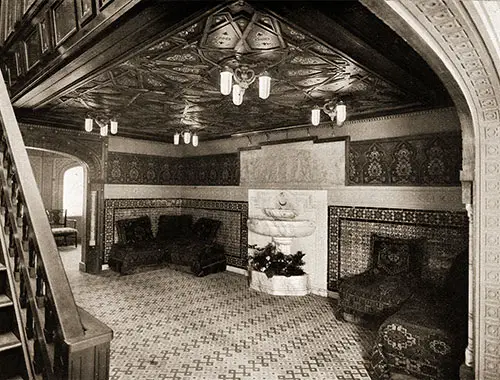
Moorish Lounge. The New SS France Liner, 1912. GGA Image ID # 119ea683db
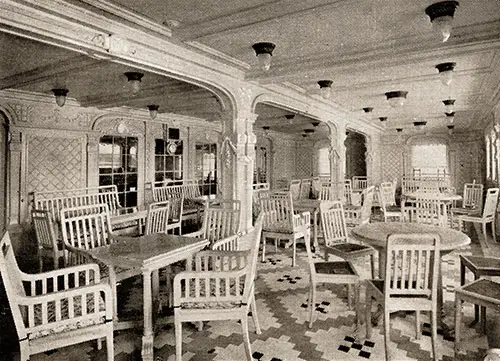
Café Terrace. The New SS France Liner, 1912. GGA Image ID # 119f547509
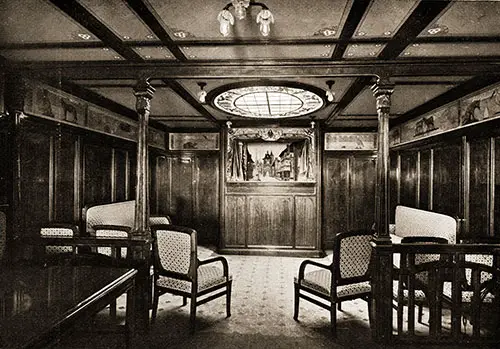
Children's Games Room. The New SS France Liner, 1912. GGA Image ID # 119d5fd284
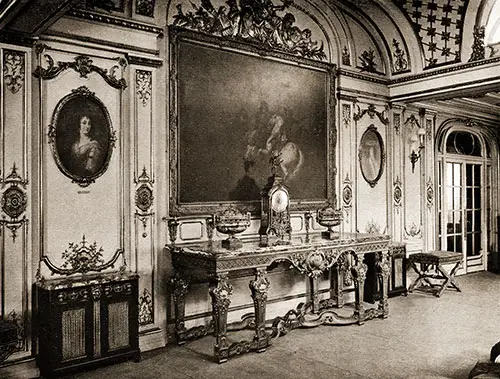
Grand Salon of the First Class. The New SS France Liner, 1912. GGA Image ID # 119e6283d6
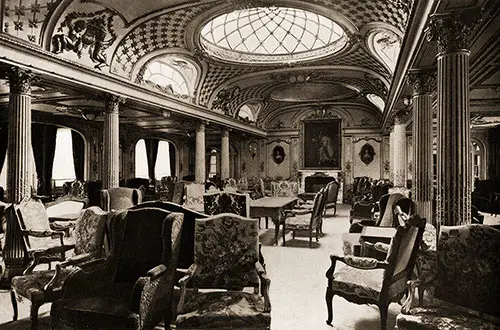
First Class Grand Salon. The New SS France Liner, 1912. GGA Image ID # 11a0ad5f29
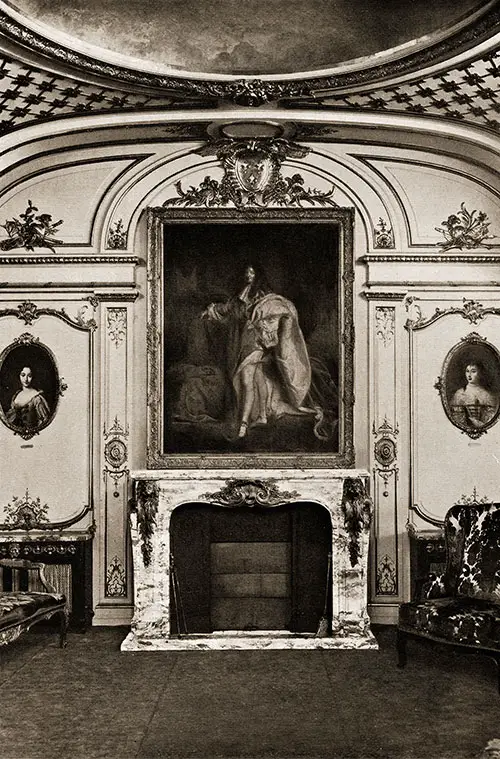
Fireplace of the First Class Grand Salon. The New SS France Liner, 1912. GGA Image ID # 11a0bee5b3
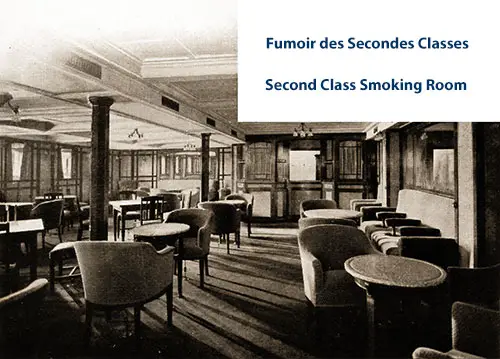
Second Class Smoking Room. The New SS France Liner, 1912. GGA Image ID # 119dff436a
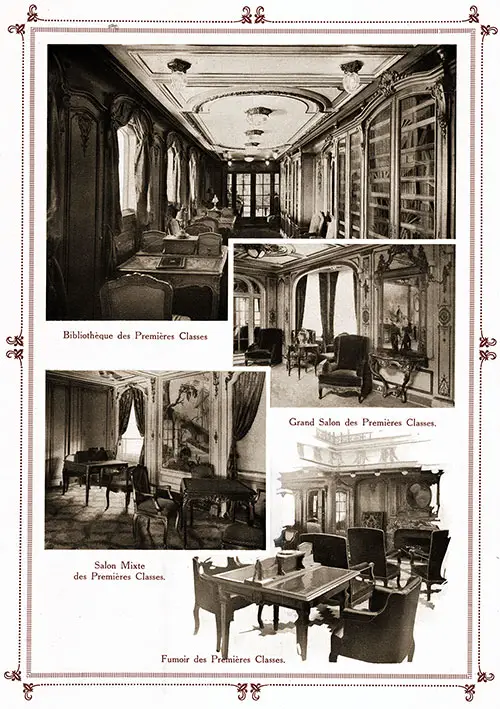
Collage of First Class Accommodation of the Steamship France (1912). From top to bottom: First Class Library; Grand Salon of the First Class; Mixed Use Lounge of the First Class; and First Class Smoking Room. The New SS France Liner, 1912. GGA Image ID # 119f72efb7
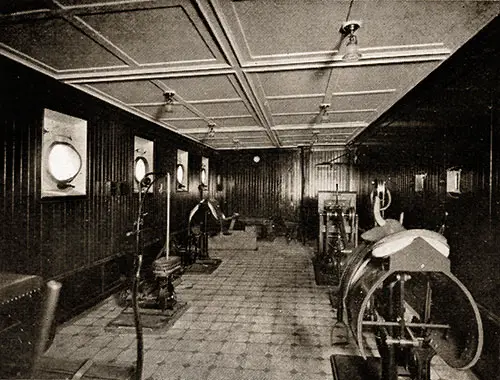
Mechanotherapy. The New SS France Liner, 1912. GGA Image ID # 119f14bc01
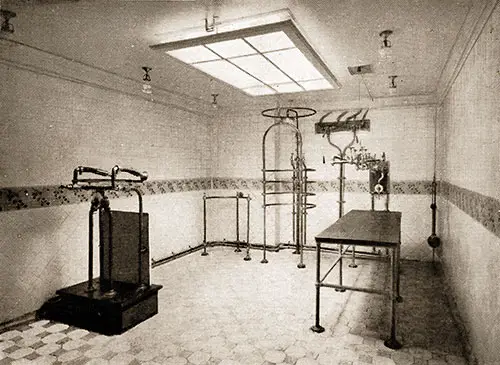
Hydrotherapy. The New SS France Liner, 1912. GGA Image ID # 119f712337
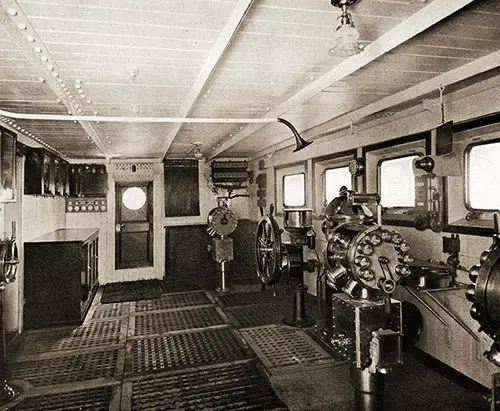
The wheelhouse. The New SS France Liner, 1912. GGA Image ID # 11a0f7402a
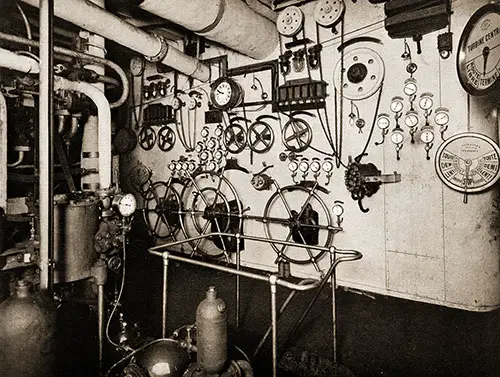
Turbine Maneuvering Table (Control Room). The New SS France Liner, 1912. GGA Image ID # 11a17f0d11
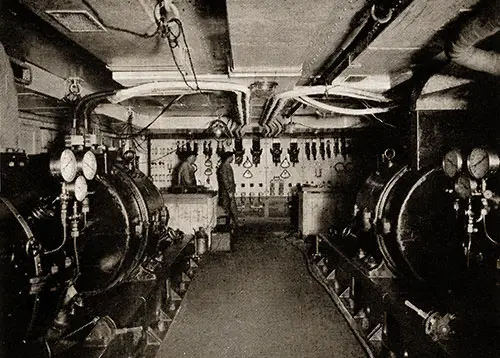
Group of Dynamos. The New SS France Liner, 1912. GGA Image ID # 11a1105ee9
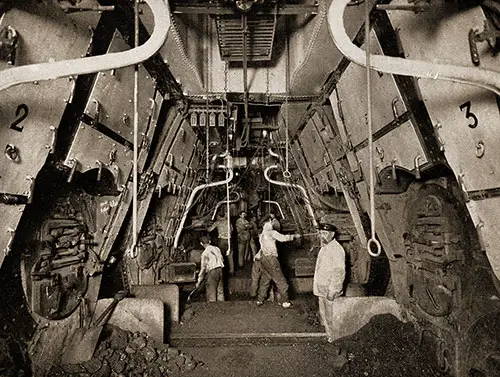
Stokers Keep The Coal Fires Burning in the Boiler Room. The New SS France Liner, 1912. GGA Image ID # 11a1519802
Return to Content Links
Information for Passengers - 27 September 1924
Going to New York
All baggage (excepting hand bags, etc.) must be checked at Gare St. Lazare the day before departure. Cabin trunks will be sent direct from the steamer train to the- proper cabins.
Passengers are eautioned that the utmost care should be taken in filling out the questionnaire for the United States Immigration authorities, as any error may result in conside-rable inconvenience, or possibly in detention of the passenger.
Great care should also be exercised in filling out the United States Customs declarations, showing the exact number of pieces of baggage, listing all articles acquired since leaving the United States, and stating the full value of all such articles. Returning citizens are entitled to free entry of one hundred dollars’ worth of goods acquired abroad. In filling out this declaration, a close adherence to the directions given thereon will obviate a great deal of delay on reaching New York.
Arrival in New York
All hold and cabin baggage is removed from the steamer as quickly as possible upon arrival, tend is placed on the pier beneath the letter corresponding to the initial letter of the passenger’s last name. When all baggage has been assembled, the passenger presents, at the Customs desk, the numbered slip tom from the bottom of the declaration and an inspector will be assigned to examine the passenger’s baggage.
The receipt for baggage cheeked at Gare St-Lazare before departure from Paris will be taken up by a representative of the Company’s baggage department as the passenger passes out through the Customs barrier in New York.
The Company’s Baggage Master on the Pier, will, on request, check baggage to home, hotel or railroad station.
Representatives of railroad, telegraph, and express companies will be found on the pier at the service of passengers.
Telephone booths are located on the pier, for local or long distance service.
Public taxicab stands are located in front of the pier.
Information Bureau
An information bureau has been provided for the convenience of passengers, and all requests for information of a general character should be made here. Radiograms, cablegrams, telegrams and letters will be received here for dispatch, and no member of the ship’s staff, other than those on duty at this office, is authorized to accept such communications. Passengers are requested to ask for a receipt on the Company’s form for the telegram. Here mail will be distributed and postage stamps may be purchased.
Passengers should personally ascertain, before disem-barking if there is any mail for them at this office, and may, if they so desire, leave a forwarding address, in order that any communications received after they have left the ship may be re directed.
Charges Collected on Board
Passengers are requested to ask for a receipt on the Company’s form for all charges collected on board.
Changes in Accommodations
No changes can be made in the accommodations of passengers except officially by the Purser.
Wireless
The steamer is almost always in communication either with shore stations or passing steamers. The Information Bureau will give information regarding rates and wil receive messages for transmission.
Stenographer
An experienced stenographer is on board, whose services are at the disposal of passengers. Rates for this service may be had on application at the information bureau.
Tourist Information Bureau
A tourist information bureau has been established on board of the Paris and is in charge of a competent repre-sentative of the Office National du Tourisme. Here all travel and tourist information may be obtained, reservations made for hotels, steamers, railroads, and automobiles and necessary tickets secured.
North African Motor Tours
Full information, reservations and tickets for the North African Motor Tours, conducted by the Compagnie Generate Transatlantique may be obtained at the Purser’s Office.
Baggage Insurance
Passengers are urged to insure their baggage, as the French Line’s liability is strictly limited in accordance with the contract ticket. All inquiries regarding baggage should be made to the baggage master on the pier before sailing, or to the baggage master on board.
Valuables
Passengers are cautioned not to keep money, jewelry and other valuables in their state-rooms.
- On board all liners, valuables may be left at the Information Bureau for deposit in the ship’s safe. Special envelopes to be sealed and marked with owner’s name will be supplied. No charge is made for this service
- In addition, both s/s “Paris” and “France ” are provided with a safe deposit vaults, similar to those of a modern bank, which is placed at the disposal of passengers. Individual compartments may be obtained upon payment of f 1.00. Keys of individual compartments are left in charge of travelers during the whole crossing, thus allowing them free access to their valuables whenever they so desire
Therefore, the French Line cannot accept any responsibility for loss or damage Passengers can protect themselves by insurance which may be obtained by application to the purser’s office.
Exchange of Money
For the convenience of passengers, the information bureau attendant is prepared to exchange a limited amount of money; rates will be quoted on application.
Claim, etc.
Passengers desiring to file letters of claim, commendation, or complaint, are requested to present them to the Purser.
Recovery of U.S. Head Tax
All aliens sixteen years of age and over are requires to pay a United States Government Head Tax of $ 8.00 at time of purchasing their tickets for the Westbound voyage. Children under sixteen years, when accompanied by father or mother, are exempt. Aliens in transit through the United States, or on a temporary visit not exceeding 60 days, can secure refund of this Head Tax, providing they inform the U. S. Immigration Inspector, on arrival at New York, of their intention to leave the United States within 60 days, and obtain from him Transit Certificate, form 514. This certificate must be signed by the Conductor of the Train or Purser of the Vessel on which the passenger leaves the United States, and returned to the Company’s Office at 19 State Street, New York City within 120 days from date of arrival.
Post Office
A Post Office under the management of a representative of the French Government Postal Service is on board, where postal money orders, stamps and post cards may be obtained, mail registered, and all usual post office business transacted.
Passenger's addresses
Passenger’s addresses may be left at the Information Bureau, in order that any letters received after passengers have left the ship may be forwarded.
Passenger’s may have Mail, Telegrams and cables sent to the care of any of the French Line Chief Offices.
Meals
Meals will be served as follows
Breakfast ... 7 to 9:30 A.M 7 to 8:30 am
Luncheon 12:15 P.M Noon
Tea 3 to 5 P.M 3 to 4:00 pm
Dinner 7:30 P.M 7 P. M.
A gong is sounded half an hour before and at the beginning of meals
Seats at Table
Seats at the dining-tables are assigned by the Second Steward immediately after sailing, governed as far as possible by the wishes of the passengers. Children are not entitled to seats in the main dining-saloon unless full fare is paid.
Smoking
Passengers are requested not to smoke in the dining rooms, music rooms, library, or staterooms
Wines
Wine is served without charge at luncheon and dinner during the voyage. When ordering special wines, champagnes, cordials, aperitifs, etc., passengers are requested to sign cards at table. Accounts for these will be presented at the end of the voyage by the dining room sergeant to whom payment should be made.
Bar
The bar opens at 7.30 A. M. and closes at 11:00 pm, but it is within the discretion of the Captain, at any time during the voyage, to close it should he consider this course advisable.
Professional Gamblers
Passengers are informed that professional Gamblers are reported as frequently crossing on Atlantic Steamers, and are warned to take precautions accordingly.
Ice Room
The Ice Room is at the disposal of passengers who desire to preserve fruits, flowers, or other perishables during the voyage.
Baths
Passengers will please arrange the hours for their baths with the bathroom steward or stewardess.
Berth-Ladders
These may be obtained on application to the steward or stewardess.
Chairs and Rugs
Deck chairs can be hired from the deck steward at a charge of $1.50 each for the duration of the voyage. Steamer rugs are also available at $ 1.50 each. Chair cushions can also be arranged for with the deck steward. Blankets and pillows must not be taken from the staterooms for use on deck.
Gymnasium
A gymnasium, completely equipped with the most modern apparatus, and in charge of a competent instructor, is available for exercise for passengers. No charge is made either for the use of this equipment or the services of the instructor.
The gymnasium supplied with modern appliances is situated on Deck » B » and is open for the use of passengers as follows : ladies and gentlemen from 8:00 am to 1:00 pm and 8 p. m. to 6:00 pm children : from 1:00 pm to 3:00 pm
Massage
A massage room an electric bath cabinet and two shower bath rooms in charge of an experienced masseur are in the gymnasium.
Valet Service
In charge of an expert tailor, a pressing and cleaning room is available for the use of passengers having any such work to be done, rates for which may be had on application at the information bureau.
Medical Attention
The ship’s Doctor is at the disposal of passengers requiring his professional services, for which no charge is made. In all cases, medicine will be furnished free by the Company when prescribed by the Doctor.
Barber
The barber-shop is open from 8:00 am to Noon and 2 P. M. to 7:00 pm, and a fixed tariff of charges is posted therein. The barber is also allowed the privilege of selling various articles.
Hair Dressing
The ladies’ hairdressing parlor is open from 8:00 am to Noon and 2 P. M. to 7 P. M., and a fixed price-list may be found posted there.
Manicure
The services of a manicurist are at the disposal of the passengers at a fixed rate which will be advised upon application.
Dogs
Dogs will be carried at the owner’s risk, in the kennel, at the rate of $ 15.00 each and tickets for them should be obtained at the time of securing passenger’s own ticket. In instances where this has not been done, the Purser is authorized to collect the charges. Dogs to be landed in England require a special license from te Secretary of Agriculture in London. Without such license they will not be received on board ship. There are no restriction as to the landing of dogs in France.
Elevators
Passenger elevators provide between decks B. C, D, and E.
Cleaning of Shoes
Shoes left outside of cabin doors in the evening will be cleaned free of charge. However, the French Line accepts no responsibility for thefts resulting from passengers taking advantage of this service.
Church Services
Mass on Sunday at 9:30 AM. in the grand salon.
Deck Games and Amusements
Golf, Croquet, Bull Board, Shuffleboard, Deck Quoits Tonneau and other games are provided on deck and may be had from the deck steward on application. Chess, Mah Yougg Checkers, Dominos, Jacquet, etc., can be had on application to the lounge or smoking room stewards.
Movie Shows
Series of cinematograph shows are given every day on board all.
The orchestra is playing during the shows.
Library
A large and well-chosen library is at the disposal of passengers and books may be obtained from the steward in charge, subject to the rules of the Company. Passengers are urged in the interest of their fellow-passengers, not to delay in returning books to the library after they have been read. The borrower must pay the full value of lost or damaged books.
Picture Postcards
Picture postcards and sectional views of the steamer can be obtained at the information bureau and at the library.
Orchestra
An orchestra of professional musicians will play at times and places mentioned below:
| 2:15 to 3:00 pm | second class salon |
| 4 to 5:00 pm | first class salon mixte |
| 5:00 pm to 6:00 pm | during the movies show |
| 9 to 10:00 pm | first class grand salon |
| 10 to 11:00 pm | first class grand salon (for dancing) |
Children’s Playroom
A playroom has been provided for children forward on B-Deck. A Punch and Judy Show (Guignol) is presented here each day at 3:00 pm
Photographic dark room
The Guignol attendant has charge of the Photographic Dark Room for any work on plates, films and prints for passengers.
Magasins du Louvre
There has been established on board, in charge of a competent representative, a branch of the Parisian depart-ment store, Les Grands Magasins du Louvre, where a large assortment of merchandises and objets d’art is on sale.
Source: SS France Passenger List - 27 September 1924
Return to Content Links
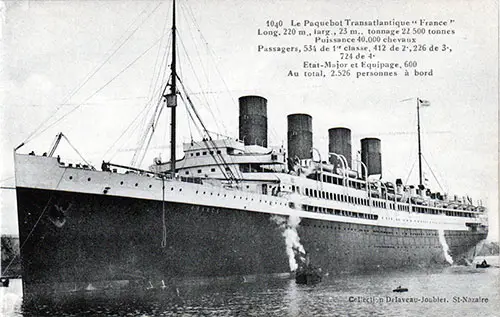
Vintage Postcard of the SS France of the CGT French Line (1912). PC 1040 Le Paquebot Transatlantique "France"; Length 220 meters; Breadth 23 meters; Tonnage 22,500; Horsepower 40,000; Passengers: 534 First Class; 412 Second Class; 226 3rd Class; and 724 Steerage. Crew: 600; Total Capacity: 2,526 people. GGA Image ID # 1e7f84a29a
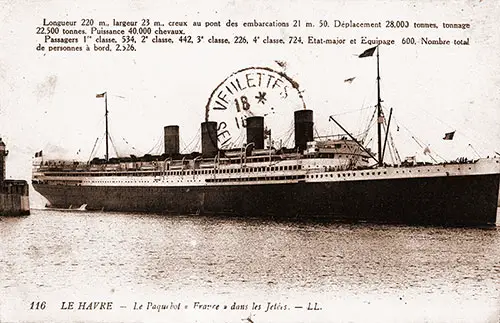
Front Side of a Picture Postcard of the SS France at Le Havre, Postally Used 15 September 1922. GGA Image ID # 178865bfe6
Return to Content Links
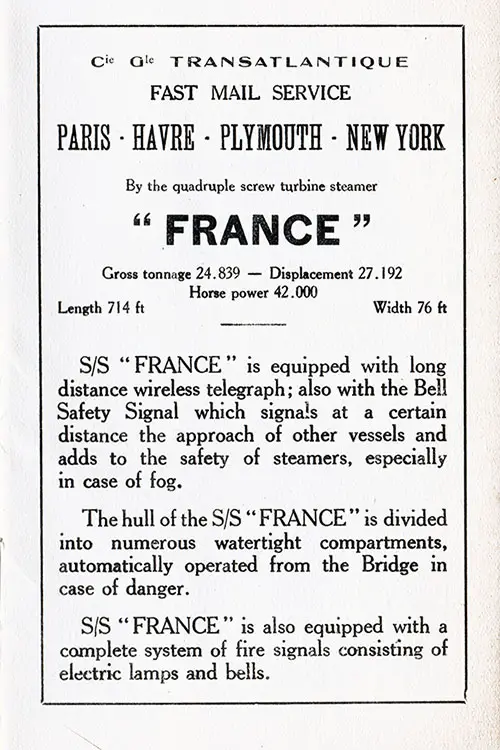
Advertisement -- Fast Mail Service, Paris-Le Havre-Plymouth-New York by the SS France. GGA Image ID # 1e7f8864a2
FAST MAIL SERVICE PARIS • HAVRE • PLYMOUTH • NEW YORK By the quadruple screw turbine steamer FRANCE Gross tonnage 24,839 — Displacement 27,192 Horsepower 42.000 Length 714 ft, Width 76 ft.
SS FRANCE is equipped with a long-distance wireless telegraph and the Bell Safety Signal, which signals at a certain distance the approach of other vessels and adds to the safety of steamers, especially in case of fog.
The hull of the SS FRANCE is divided into numerous watertight compartments, automatically operated from the Bridge in case of danger.
SS FRANCE is also equipped with a complete system of fire signals consisting of electric lamps and bells.
Return to Content Links
By M. Gouriet—Le Genie Civil
The Compagnie General Transatlantique fleet has been augmented recently by adding its lines to the largest vessel yet constructed in French shipyards.
The SS France, built at the Saint-Nazaire yards, sailed on the 20th of April on its first trip in the service of its company from Havre bound to New York.
This vessel continues the line of ships, Lorraine, Savoie, and Provence, built since 1898 at the same yards and destined solely for the rapid transport of mail and passengers across the Atlantic.
Work commenced on the SS France on the 20th of April, 1909; it was launched on the 20th of September, 1910, at which time its displacement was about 11,300 tons — the heaviest launching weight yet occurring in French yards. The total time for its construction was precisely three years.
The maximum dimensions of the SS France are as follows:
- Length overall..................217.23 m.
- Length between perpendiculars........208.83 m..
- Extreme breadth.................. 23.00 m.
- Depth to upper deck.............. 24.00 m.
- Maximum displacement.............27,180 tons
- Draught under load................ 9.10 m.
- Cargo capacity................... 1,400 cu.m.
- Bunker capacity.................. 4,200 cu.m.
- Number of decks...................... 8
- Number of transverse bulkheads 13
- Number of lifeboats................. 22
The weight of passengers, provisions, and cargo represents but 2.8 percent of the total displacement of 27,180 tons. This fraction of liner displacement is decreasing; on the Savoie, which was placed in service in 1901, it was 7.5 percent; on the Provence, which made its first trip in 1906, it was not more than 4.7 percent. From such small items, one can appreciate the great care exercised toward the economy in avoidable weight.
The SS France will have a maximum list of 2,526 persons, divided as follows; 534 first-class passengers, 442 second-class, 950 third-class, and 600 officers and crew, including stewards, stewardesses, stokers, etc.
The hull plates have a minimum thickness of 20 millimeters. In the bottom, the plates and members are of soft steel with resistance against 50 kilograms per square millimeter rupture. In the upper plates, high-tensile steel had a resistance of 60 kilograms per square millimeter.
A double bottom runs nearly throughout the ship's length and is divided by fifteen watertight compartments comprising the water ballast. This assures the stability of the vessel proportionately to the coal consumption.
This water ballast has a total capacity of 1,967 cubic meters, representing about 2,018 tons of salt water when filled. There are also two water ballasts for fresh water, with a full capacity of 725 cubic meters.
On leaving port, the ship carried 800 tons of fresh water, of which 400 were used in the engines and 400 for passengers and crew. This amount provides 20 liters of wash water and 6 liters of drinking water per capita per day.
The ship is divided crosswise into fourteen compartments with thirteen watertight bulkheads. As used in the earlier vessels, the bulkhead doors are operated on the Stone-Lloyd hydraulic system, with the control point on the bridge. The filling of any two transverse compartments would not affect the navigability of the ship.
There are four boiler rooms, each occupying a transverse compartment, placed one before the other, and having a total length of 77 meters. The boilers are cylindrical with four to eight furnaces; 11 double-ended boilers with eight furnaces each, and eight with four furnaces each, or 120 for the nineteen boilers.
Electricity is necessary for light, and power is supplied from two equal-powered stations on the G deck. Each of these stations operates two 400-watt turbo motors. The forward station operates the lighting and cabin ventilating systems, while the after station furnishes power for the furnace draft fans. These stations are interconnected, however, and either may perform the duties of the other.
A Cail refrigerating engine employs and operates the Linde duplex ammonia refrigerating system.
The interior arrangements on the SS France differ materially from those on the other ships. For example, the lowest continuous deck, G, is traversed by a large passageway that communicates with the several transverse compartments, doing away with the necessity of descending to the hold and opening the bulkhead doors.
In this large passageway are found the more significant part of the necessary auxiliary supplies, not only for the boilers and furnaces but also for the life and safety of the ship. The passageway also opens at the stern into various provision magazines and quarters for stokers, stewards, etc., and quarters for emigrants and crew at the bow.
The accommodations for first-class passengers occupy all the upper part of the ship and most of the lower decks. Quarters for the second-class passengers occupy the several decks at the vessel's stern, while the third-class is forward.
The first-class salons are the most spacious and finished with all possible conveniences. The cabins are all equipped with bathrooms, and the state-room suites contain every luxury.
Second-class cabins could be much better in their accommodations than first-class cabins. They are much more luxurious than first-class on the older boats.
In the trials of SS France, an average speed of 25 knots was maintained for twenty-four hours, which exceeded all expectations. With the exception of the Mauretania and Lusitania of the Cunard line, the SS France is the fastest steamship in the world.
At this speed, the engines developed 47,000 horsepower. Yet, the coal consumption was one-tenth less than estimated before the trials.
M. Gouriet, "The Steamship France of the French Line," in The Engineering Magazine, Volume 43, No 4, July 1912: 610-612.
Return to Content Links

A Century of Sea Travel: Personal Accounts from the Steamship Era
This book is a voyage through the life of the passenger steamship, a voyage described by travellers who sailed on these vessels, and it carries within it their thoughts and experiences, mirrored here in words and pictures.

Christie's Ocean Liner Auction Catalog - 2007
The Christie's Ocean Liner Auction Catalog 2007 included Posters, Ship Models, and Decorative Arts. The provenance of the Items was sourced from The Estate of Wayne LaPoe, The Kenneth C. Schultz Collection, The Jan J. Loeff Collection, The Marcello Collection, and The Collection of Terrence G. O'Connor.

Distinguished Liners from The Shipbuilder - 1906-1914 Volume 1
An authentic replication to the smallest detail of the best of The Shipbuilder magazine, 1906-1914, including articles on the Titanic, Olympic, Lusitania, Mauretania, and more. This encyclopedic collection contains original text, photographs, and advertisements, as well as 22 fold-out blueprint plans, five color plates, a two-color Titanic cutaway folding advertisement and even two facsimile subscription forms.

Doomed Ships: Great Ocean Liner Disasters
Naval historian William H. Miller, Jr. recounts the dramatic stories behind various ill-fated passenger ships. He takes readers beyond the newspaper headlines and formal inquiries, offering firsthand accounts of heroic rescues, daring escapes, and tragic losses.
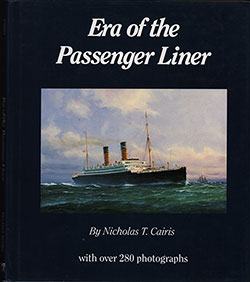
Era of the Passenger Liner - 1992
The Gilded Era comes back to life as the reader relives the careers of stately ships and express greyhounds from immigrant ships to floating palaces. Scarce, large format book containing 288pp. Features photographs, statistics, and background of 280 passenger liners, each with a picture.

The Fabulous Interiors of the Great Ocean Liners - 1984
Some 200 superb photographs—in long shots and close-ups—capture exquisite interiors of world's great "floating palaces"—1890s to 1980s: Titanic, Île de France, Queen Elizabeth, United States, Europa, more. Informative captions provide key details.
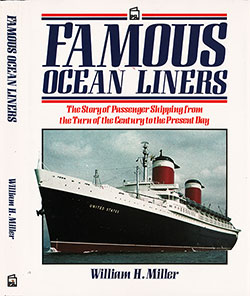
Here is the story of twentieth-century passenger shipping, from the first of the superliners — the German Kaiser Wilhelm der Grosse — to Cunard's Queen Elizabeth and Queen Mary, right up to Queen Elizabeth 2.

The First Great Ocean Liners in Photographs - 1983
Sumptuous volume recalls the glorious early years of elegant transatlantic travel. Over 190 historic photographs depict exterior and interior views of 101 great ocean liners, including the Virginian, Imperator, Vaterland, Bismarck, Lusitania, Mauretania, Balmoral Castle, Titanic, Olympic, Aquitania and dozens more. Full captions.
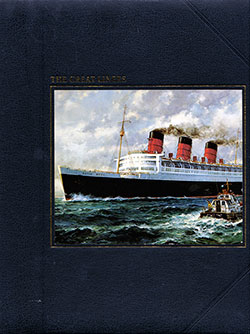
The Great Liners: The Seafarers, Volume 4
A history of the world's famous luxury liners provides portraits of the ships. It examines such great disasters as the sinking of the Titanic. This edition explores the grand hotels that traversed the Atlantic between 1840 and 1930.

Great Passenger Ships of the World 1858-1912
This initial volume deals with Ships from 1858-1912, from the first passenger ship of over 10,000 GRT to be placed in service (the Great Eastern) to those unforgettable sister ships, the Olympic and Titanic — the first of more than 40,000 GRT.

Great Passenger Ships of the World 1951-1976
This volume, covering the years 1951-1976, embraces a period of dramatic change in ocean travel, the growth in airline travel causing a sharp decline in passenger liner building and existing liners being increasingly used in the cruising role.

Le Havre - New York: French Line
This volume about the French Line and its route from Le Havre to New York is a witness to crossing the Atlantic from before WWI to today (1997)—a fascinating visual record of travel.

Leviathan: "The World's Greatest Ship" Volume 2
Volume 2 picks up the LEVIATHAN saga during her monumental conversion from a troop ship to a luxury liner and carries the ship’s tempestuous life up through her first round trip as a U.S. express liner. The book finishes with the SS Leviathan's triumphant return to the Atlantic.

Lost Liners, Titanic to the Andrea Doria
Maps, charts, and diagrams make this handsome volume a valuable reference tool and a compelling evocation of that glorious era when floating palaces ruled the sea lanes.

Majesty at Sea: The Four Stackers
The opulent and luxurious four-funnel passenger liners, of which only fourteen have ever been built, are unsurpassed in maritime history. Built between 1897 and 1921, these great vessels vied with each other in their standards of comfort, spaciousness, and speed, and great was the rivalry between their owners.

North Atlantic Passenger Liners Since 1900
Material about the most prominent steamship companies on the Atlantic Ferry today and those that have been there for some time. Some Lines have diverse services to other oceans, seas, and continents.

This book recreates the ambiance of the ocean linereraby showing the actual objects used on board. Each piece of ocean-liner memorabilia is like an aladdin's lamp, releasing wondrous memories of that grand style of travel.

Ocean Steamers: A History of Ocean-Going Passenger Steamships 1820-1970
A history of the steam-powered passenger ship that details its story from the SS Savannah of 1819 to the SS Hamburg of 1969. It contains historical details of all civilian vessels built in the intervening years, with numerous illustrations and previously unpublished material.
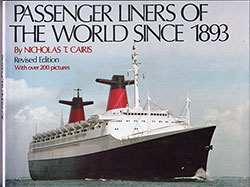
Passenger Liners of the World Since 1893
The author here takes a nostalgic look back to the heyday of the passenger ship, providing a brief history of 211 ships of over 10,000 tons, together with specifications and technical details of each.

Passenger Ships of the World - 1963
Passenger Ships of the World, 1963, represents an incredible resource covering passenger ships that are Trans-Atlantic, Trans-Pacific, Trans-Pacific via Panama Canal, Latin American, Africa and the Eastern Oceans, and California-Hawaii.

Pictorial Encyclopedia of Ocean Liners, 1860-1994
One of the most comprehensive pictorial references on ocean liners ever published, this superb chronicle by noted maritime historian William H. Miller, Jr., depicts and describes virtually every passenger ship of over 15,000 tons built between 1860 and the late 1900s.

Picture History of the Andrea Doria
Graceful, fast, and luxuriously outfitted, the Andrea Doria was one of the most famous ships of the 20th century. On July 26, 1956, three years after its inaugural voyage, the famous Italian liner was assured of an immortal place in maritime history after colliding with another vessel off the New England coast and sinking.

Picture History of the Cunard Line 1840 - 1990
The Picture History of the Cunard Line 1840 - 1990 has over 180 photographs and illustrations showing the liners on the high seas and in port and depicting handsome staterooms, lounges, interior decor, and carefree life aboard ship.

Picture History of the French Line
This impressive pictorial reference, by noted maritime historian William H. Miller, Jr., includes a wealth of vintage photographs celebrating the legendary French Line.

Picture History of the SS United States
A comprehensive pictorial record of the SS United States that will appeal to maritime historians, this celebration of an American champion and centerpiece of national pride will also captivate ship lovers and anyone thrilled by sea travel.

Sway of the Grand Saloon: A Social History of the North Atlantic
History of the ocean liners of the North Atlantic crossings. A comprehensive history of Trans-Atlantic passenger ships covering 1818 - 1968, with 55 b/w illustrations, photos, and drawings.

The Art of French Ocean Liners: The Triumph of Art Deco
Embark as if you were there, on the liners France, Normandie, Paria, Liberie', Champollion, Aramio, André Lebon, Antilleo, or Ile-de-France, and share the daily lives of the passengers, but also that of all those who work in behind the scenes so that each crossing is an unforgettable dream.
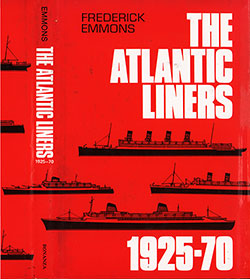
THE ATLANTIC LINERS will be cherished by all the millions of Americans who love the sea. Frederick Emmons sketches the histories of every ocean liner that sailed between the United States and Europe between 1925 and 1970.

The Only Way to Cross: The Golden Era of the Great Atlantic Express Liners
The book profiles the opulent lifestyles aboard such floating palaces as Normandie, Rex, Olympic, Amerika, Queen Mary, France, Mauritania, Queen Elizabeth II, Imperator, and Titanic.

Tourist Third Cabin: Steamship Travel in the Interwar Years
Ocean Liners and New Vistas of Interwar Society From Immigrants to Tourists. The Changing Complexion of Translatlantic Passengers as The Soul of a Ship. Experience and Life of Below-Deck Personnel Traveling Palace or Floating Sweatshop. The Experience of Women Seafarers Projecting an Image: The Allure of MTransatlantic Travel.

The liners of this age served the route of gold linking Europe with the brazenly rich United States of America, where a new class of person was learning how to spend money as lavishly as any Old World rentier.
Return to Content Links
